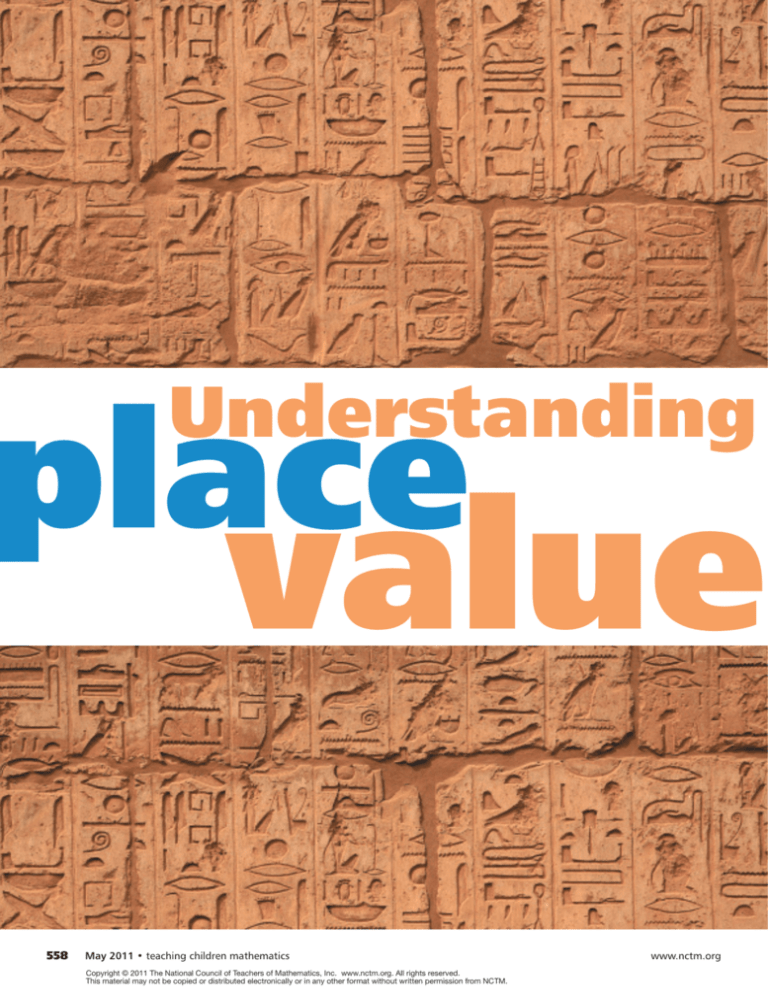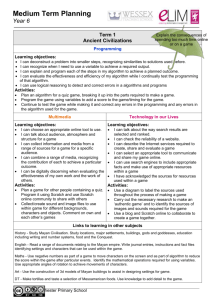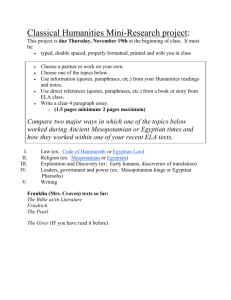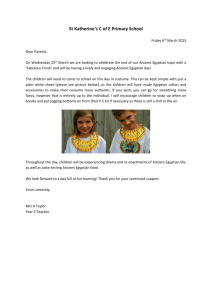
place
Understanding
value
558
May 2011 • teaching children mathematics Copyright © 2011 The National Council of Teachers of Mathematics, Inc. www.nctm.org. All rights reserved.
This material may not be copied or distributed electronically or in any other format without written permission from NCTM.
www.nctm.org
By Linda L. Cooper and Ming C. Tomayko
Developing an understanding of place value
and the base-ten number system is considered
a fundamental goal of the early primary grades
(NCTM 2000, 2006). For years, teachers have
anecdotally reported that students struggle
with place-value concepts. Among the common
errors cited are misreading such numbers as
26 and 62 by seeing them as identical in meaning, failing to recognize that numbers can be
www.nctm.org
composed of tens and ones, and incorrectly
believing that large digits result in larger values
regardless of the position of the digit (Kari and
Anderson 2003; Sharma 1993). Results from a
number of research studies support the notion
that students lack an understanding of place
value and have difficulty distinguishing between
the values of the tens and ones places (Hanich
et al. 2001; Jordan and Hanich 2000; Kamii 1985,
WORLDWIDEIMAGES/ISTOCKPHOTO.COM
Exploring ancient numbers helps students
focus on the structure and properties of
our Hindu-Arabic system.
teaching children mathematics • May 2011
559
47
248
672
5309
Each child created an Egyptian mystery number and kept the
solution a secret. After challenging one another, they later
compared answers.
To explore place value,
students decorated
and baked cookies
with representations
of Mayan number
symbols.
560
May 2011 • teaching children mathematics 1989; Kamii and Joseph 1988; Ross 1986, 1989;
Ross and Sunflower 1995).
Kamii (1985) and Kamii and Joseph (1988)
found this to be most prevalent in first grade,
where none of their study’s students correctly identified that the numeral 1 in 16
corresponds to a physical representation of
ten ones; instead they indicated that the 1
simply corresponds to one unit. Hanich and
her colleagues (2001) and Jordan and Hanich (2000) reported similar findings among
second-grade students. This misconception
persisted through fourth grade, where only
50 percent of the students could associate the
tens digit with the appropriate physical representation (Kamii 1985; Kamii and Joseph 1988;
Ross 1986, 1989). Although students are
expected to understand place value as early
as second grade, these results indicate that
true understanding does not occur until much
later. An underdeveloped understanding of
place value can have far-reaching
consequences. Notably for the
elementary school student, it
can inhibit and slow conceptual
understanding of the basic arithmetic algorithms, whose representations rely on a place-value
foundation.
During a summer enrichment
program that we developed and
taught, we set out to strengthen
understanding of place value
through a series of activities that
put students in the unfamiliar setting of working with two ancient
number systems (Egyptian and
Mayan) whose rules differed from
our own. The participants were
three students from a suburban elementary school, who had
just finished either second grade
while working above-grade level
or third grade working at grade
level. The disposition of these
students ranged from being insecure and unenthusiastic to selfassured and passionate about
mathematics. Their parents had
asked us to arrange a summer
mathematics program that would
engage the children. Aware of the
www.nctm.org
LINDA L. COOPER
Figu r e 1
Figur e 2
Students were given numbers and asked to draw the
equivalent Egyptian symbol.
The Egyptian number system
Our first effort to better understand the meaning and use of place value was to look at a
number system that has no place value. The
Egyptian number system, a base-ten system,
uses the additive property, where the value of a
number is determined by summing the values
of the symbols that collectively represent that
number. Although sources (Billstein, Libeskind,
and Lott 2007; Leimbach and Leimbach 1990)
differ as to whether order is important, we told
our students that order of symbols does not
matter. We first gave them Egyptian numbers
(see table 1) and asked them to find the equivalent Hindu-Arabic number. Then, given HinduArabic numbers, students were to write the
numbers in the Egyptian system (see fig. 1).
www.nctm.org
table 1
benefits of reinforcing place-value concepts,
concepts that these second- and third-grade
students, regardless of mathematics ability,
were all still developing, we chose to develop
activities around ancient number systems.
We conjectured that students’ unfamiliarity
with systems other than their own base-ten
system would necessitate that they focus
their attention on the underlying properties
of these “new” systems. By learning how to
read and write numbers in a system without
place value and one whose use of place value
differed from our own, students’ understanding of place value would be enriched, both
globally and specifically to its role within our
own Hindu-Arabic number system. Finally,
we anticipated that students would respond
enthusiastically to these explorations and
would be more amenable to discussing place
value in these new surroundings.
The activities we describe could be modified for various audiences who would benefit from deepening their understanding of
place-value concepts: as a supplement to the
curriculum for primary-grades students, as
center activities for more independent intermediate-grades students, and as an appealing connection to discussions of ancient
civilizations in social studies. In addition to
enrichment activities, these have the potential to challenge place-value misconceptions
held by students whose understanding of our
own number system is largely limited to rote
procedures.
The ancient Egyptian number
system used everyday symbols
that were familiar to the culture.
HinduArabic no.
Egyptian
symbol
Explanation
of symbol
1
a staff
10
an arch
100
a coiled rope
1000
a flower
A mystery-number activity
After all three students practiced converting
Egyptian numbers to Hindu-Arabic equivalents, we asked them to use Egyptian symbols to construct a number for their peers to
convert. They attended to the task with great
enthusiasm as they tried to stump one another.
Each student created an Egyptian mystery
number and kept a separate record of the
solution (see fig. 2). They swapped papers and
quickly got to work interpreting the Egyptian
numbers. Once completed, the student who
created the mystery number checked the classmate’s solution against his or her own.
Writing numbers
Observing that the students picked Egyptian
numbers with many symbols for the mystery
number activity, we segued into a discussion
about a disadvantage of the Egyptian number
system. We asked, “Can you think of a number
that would not be easy to write using Egyptian
symbols?”
At first, the children thought that numbers
of larger values would be more difficult to write.
To focus their attention on the issue of efficiency, we asked them to write the numbers 9
and 21 in both Hindu-Arabic and Egyptian and
then compare them. Although writing
21 versus
∩∩ |
teaching children mathematics • May 2011 561
did not involve much difference, Riley noted that
writing the number 9 in Hindu-Arabic is faster
than writing it in Egyptian. We probed further by
asking why it is faster. Riley responded, “There
were fewer symbols to write.” He counted and
found that writing 9 in Hindu-Arabic requires
only one symbol but that writing the equivalent
Egyptian number
|||||||||
Figure 3
requires nine symbols. Students saw that the
larger the value of the digits, the more cumbersome it is to represent the number in Egyptian.
Comparing the number of symbols in Hindu-Arabic with
Egyptian showed the children how unwieldy some Egyptian
representations are.
How many numerals are needed to write the number 248 in the Hindu-Arabic
and Egyptian number systems?
Number itself
Hindu-Arabic
248
Egyptian
The three summer school students mastered Mayan numbers
1 to 19 using only the ones position.
• = 11
•• = 12
••• = 13 •••• = 14
• = 15
• = 16
•• = 17
••• = 18 •••• = 19
• = 10
• = 11
•• = 12
••• = 13 •••• = 14
• = 15
• = 16
•• = 17
••• = 18 •••• = 19
Fig ure 4
table 2
Number of digits 3
The Mayan representation of 48
illustrates how symbols in the
twenties position are placed above
symbols in the ones position.
Twenties position (2 × 20 = 40)
Ones position (1 × 5 + 3 × 1 = 8)
562
May 2011 • teaching children mathematics Hindu-Arabic numbers containing the numerals 8 and 9 are particularly inefficient to write in
Egyptian. The students compared writing 248
in both systems and found that it took fourteen
symbols to write the number in Egyptian yet
only three symbols in their own Hindu-Arabic
system (see fig. 3). For additional descriptions
of Egyptian numbers (and the Mayan numbers
to follow), refer to Billstein et al. 2007, Leimbach and Leimbach 1990, and the Internet sites
listed in the appendix.
The Mayan number system
The Egyptian number system provided these
three students with one lens to understand
place value as they investigated how a number
system works when there is no place value.
For comparison purposes, we then turned
our attention to the Mayan number system,
which has the property of place value, but
not in the way with which our students were
familiar. Unlike our base-ten system, which
uses ten digits, the Mayan system is a modified
base-twenty system composed of only three
symbols: a dot, a line, and a clamshell. Instead
of a true base-twenty system with place-value
positions of 1, 20, and 202, the Mayans used
place-value positions 1, 20, and 360 because
of their strong cultural interest in the lunar
calendar. For our purposes, we focused only on
the ones and twenties positions. Furthermore,
whereas our place-value positions are listed
horizontally in increasing order from right to
left, the Mayan place-value positions are written vertically in increasing order from bottom
to top, beginning with the ones position, followed by the twenties position.
At first we had our students concentrate
only on mastering representations of the values one through nineteen using the ones position (see table 2). In the ones position, each dot
represents “one.” Dots are listed side by side in
a row, with a row containing, at most, four dots.
A line represents five “ones.” Lines are stacked
one on top of another to represent multiples of
five, with remaining dots—each with a value of
one—placed above the lines.
Place-value positions
Our introduction of the second place-value
position in the Mayan system, the twenties
position, was the first time that these students
www.nctm.org
www.nctm.org
Figu r e 5
had been exposed to place value other than
in their own base-ten system. We asked, “Is it
just coincidence that both our system and the
Egyptian system are base-ten systems?” To
clarify, we added that both systems have “special representations for tens and hundreds (ten
tens). What is special about the number ten?”
Picking up on our use of the term base-ten,
Casey proposed that our system is called a
base-ten system because it has ten digits. We
responded, “But why does our system have ten
digits [0, 1, 2, 3, 4, 5, 6, 7, 8, 9]? Why not only four
digits [0, 1, 2, 3]?”
Finally, we asked what the Egyptians had in
common with the people who developed the
Hindu-Arabic number system that has to do
with the number ten. Riley suddenly exclaimed,
“Ten fingers.”
We followed up, “If counting on fingers led to
a base-ten system, what might have motivated
the Mayans to use a base-twenty system?”
With only a slight hesitation, Casey offered,
“Ten fingers and ten toes.” Collectively, we surmised that it would be much easier to count to
twenty using fingers and toes if you were not
wearing shoes. (The Mayan grouping of five
dots into a line may stem from having five digits
on a hand or a foot.)
In the twenties position, each dot represents
the value 20, and a line is equivalent to 5 × 20 =
100. Parallel to the ones position, there can be
four dots at most, and lines are stacked vertically with dots placed above. Symbols in the
twenties position are placed above symbols
in the ones position, leaving a significant gap
between positions. We initially chose to have
the children use a frame to delineate the ones
and twenties positions (see fig. 4).
Deciding how to write the number 20 led
the group to discuss an important function of
a special symbol within a place-value system,
namely the zero symbol, represented by a
clamshell in the Mayan system. Riley asked,
“How do you know if one dot represents one or
twenty?”
We acknowledged how important this question is and returned a question of our own:
“How do we represent one ten and no ones in
our own system?”
Casey answered, “That’s just ten.”
Jordan added, “You need a zero.”
The Mayans used a clamshell to represent
Just as they had done with Egyptian numbers, the children
wrote Mayan mystery numbers to challenge one another.
zero. Jordan, Casey, and Riley realized that
without a way to represent zero ones, it would
be impossible to differentiate whether a dot
above a line were symbols in the ones position,
equivalent to the number 6, or in the twenties
position, equivalent to the number 120:
Our next activity was to have the students
read and write Mayan numbers that involve
both ones and twenties place-value positions.
Given a Mayan number represented by lines,
dots, and possibly a clamshell, the children
separately found the values in the ones position and then in the twenties position, finally
summing to find the value of the number as a
whole. It proved to be a far more challenging
task for them to start with the Hindu-Arabic
representation and translate into the equivalent Mayan representation: They had to determine how many groups of twenty were in the
number, represent the number of twenties
using the system of dots and lines, subtract
the determined multiples of twenty from the
original number, and finally represent the
remainder with dots and lines in the ones position. Similar to our activities with the Egyptian
number system, the students wrote mystery
numbers and challenged their classmates to
find the Hindu-Arabic equivalent (see fig. 5).
Ordering Mayan number treats
Being able to make comparisons of magnitude
is a vital skill when working within a number
system. Our students ordered Mayan numbers
that served as cookie decorations. The purpose
of this activity was to have students discover
how their understanding of Mayan place value
teaching children mathematics • May 2011 563
DAVID PEDRE/ISTOCKPHOTO.COM
Comparing number systems
Teachers can use such questions as the following to prompt discussions about
number systems with and without place value:
• Whatspecial number is needed to hold a place-value position in a system with
place value? Think about how you would write such a number as three hundred
five. Do you need a special number in a system without place value?
F igure 6
• Whichtype of system is more efficient when writing numbers? In other words,
in general, does it take more symbols or fewer symbols to write a number in a
system with place value or one without place value? Think about how to write
such numbers as forty-three, seventy-eight, and ninety-nine in Egyptian, Mayan,
and Hindu-Arabic. Which one of these three systems appears to be the most
efficient? Which is the least efficient?
The teachers challenged the
children to arrange cookies in
ascending order and then look for
patterns in their sequence.
(presence or lack of symbols in the twenties
position and presence or lack of lines within a
place-value position) allowed them to quickly
make comparisons of magnitude. We provided
cookie dough, miniature chocolate chips, and
narrow chocolate strips and asked the children to decorate cookies with Mayan numeric
symbols on them. The chocolate chips represented dots, and the chocolate strips
represented lines. We did not provide for a
clamshell. In addition to the students’ cookies, we made additional cookies decorated
with numbers of larger values. After baking the
dough, we mixed up the cookies, placed them
on a tray (see fig. 6), and challenged students
with the task of working together to arrange
the cookies in ascending order. Initially, the
process was slow; students chose to determine
the equivalent Hindu-Arabic value of each
number to make comparisons. Some cookies
could be rotated 180 degrees to result in a different but valid Mayan number. After students
completed the task, we had them look for patterns in their sequence. They noticed that the
first numbers in their sequence, those of value
less than twenty, did not have symbols in the
top portion of the cookie, whereas those cookies with numbers of value twenty or greater
did. To see if this realization made a difference
in the ease of ordering numbers, we mixed
up the cookies and asked students to reorder
them. This time, students were able to complete the task more quickly (see fig. 7). They
had learned how to first order by the presence
or lack of value in the twenties position, much
as students recognize that a Hindu-Arabic
number containing a digit in the hundreds
position must be greater than a number with
only two digits.
globetrotting
Our investigation of number systems presented a novel opportunity to make connections between mathematics and social studies.
As we introduced each number system, we
encouraged students to connect the systems
to their geographical and historical origins.
We made the important point that different
cultures create their own ways of representing
numbers and mathematical ideas. In addition
to our classroom globe, students had world
map outlines on which they could each mark
564
May2011•teaching children mathematics
www.nctm.org
geographical areas of interest (see fig. 8). They
located Egypt and associated it with the great
pyramids, the Nile River, and the ancient
pharaohs. We turned the globe and guided
students to the Mayan civilization’s location
in present-day Mexico and Guatemala. They
found the Mayans’ similar use of pyramids particularly intriguing because they were unaware
that pyramids had also been constructed in
the Western Hemisphere. The online appendix
provides Internet links and directions to locate
ancient pyramid ruins using Google Earth as
well as other Web sites that provide historical
background about these civilizations.
Figure 8
Figu r e 7
Noticing that numbers lower than twenty had no symbols in the top portion of the cookie helped students
complete the same task more quickly the second time.
Using outline maps of the world, Jordan, Riley, and Casey
learned that different cultures create their own ways of
representing mathematical concepts.
The Hindu-arabic system
We next focused our discussion on the spread
of the Hindu-Arabic number system. We asked
our students to think about the name HinduArabic, which describes where the number
system developed. Specifically, we asked
which present-day country is associated with
the word Hindu. Students readily associated
Hindu with India. After being guided to the
general geographical area, they first located
India on the globe and subsequently identified
it on their outline maps. We explained that the
second part of the name, Arabic, describes the
path that the number system took as it spread
(and evolved). We asked students to find the
Arabian Peninsula and gave them the hint that
Saudi Arabia is the largest present-day country on that peninsula. Whereas our students
had some familiarity with India, including
its shape, we found that we needed to assist
them in finding Saudi Arabia and the Arabian
Peninsula. Students labeled Hindu on India
and Arabic on the Arabian Peninsula and drew
a land path to connect them (see fig. 8). Showing them where several familiar European
countries are located, we then asked how the
www.nctm.org
number system could have spread to there.
Students offered several paths, some by land
and others traversing the Mediterranean Sea.
Finally, we asked students how they thought
the use of the Hindu-Arabic number system
spread from Europe to the United States. Without hesitation, Jordan responded “Columbus.”
Yes, we acknowledged, Columbus and the
many other explorers and settlers from Spain,
England, Portugal, and so on would have
brought their Hindu-Arabic number system
with them. The journey of our number system
is just one example of how cultures spread.
Souvenir charms
For our final activity, we hoped that studentcreated souvenir charms would serve as
reminders of our explorations into ancient
number systems. Each student received pieces
of number 9 polystyrene plastic (7 × 7 cm)
and a variety of colors of permanent markers. Students were to write the names of each
ancient number system and provide examples
of numbers from those systems. Some students
teaching children mathematics • May 2011
565
form one group of ten staffs, which is replaced
with an arch and two leftover staffs.
∩∩∩∩||||| + ∩∩∩∩∩|||||||
However, a clear distinction exists between the
Egyptian and Hindu-Arabic systems. Whereas
the use of base-ten blocks physically models
and parallels the process of adding as notated
by our traditional algorithm in the HinduArabic system, a lack of place value precludes
a corresponding shorthand notation in the
Egyptian system. Adding in Egyptian is simply
regrouping symbols.
Adding numbers in the Mayan system
involves a two-tier regrouping process. Starting within the ones position, dots are combined, and groups of five dots are replaced
by a line. A sum that results in more than five
lines in the ones position results in each group
of five lines from the ones position being
replaced with a dot in the twenties position.
Once again, within the twenties position,
groups of five dots are replaced with a line.
LINDA L. COOPER
Concluding remarks
TOP: This child included
Hindu-Arabic equivalents
when drawing numbers
from other systems
on the charms. Before
baking the charms, the
teachers punched holes
in them for the students
who wanted to string
their charms together.
BOTTOM: Students
marveled as their charms
shrank in size after thirty
seconds in a hot oven.
566
included the Hindu-Arabic equivalents. We
punched holes in the charms of those students
who wanted the option of stringing them, and
then we baked the charms in a toaster oven
at 350 degrees Fahrenheit for thirty seconds.
(Heating polystyrene in a toaster should be
done in a well-ventilated area and only with
adult supervision.)
Extending the exploration
The Egyptian and Mayan systems are both
characterized by the repetition of symbols,
whether they are staffs and arches or dots and
lines. In each case, the process of combining symbols is reminiscent of the regrouping
step that children use when physically adding
base-ten blocks. Adding the Egyptian numbers
45 + 57 involves combining twelve staffs to
May 2011 • teaching children mathematics Our exploration of Egyptian and Mayan
number systems resulted in students making several connections between the ancient
systems and our own. Counting on ten fingers
and ten toes led to number systems based on
ten (Egyptian and Hindu-Arabic) or twenty
(Mayan). Before this experience, students
took for granted that numbers are always
written horizontally, with the smallest placevalue position to the extreme right. Writing
Mayan numbers was at first a game as students learned the use of symbols and vertical
place-value positioning in that system. As they
became more familiar with the Mayan system,
they began to make connections and realized
that our way of positioning place values is not
unique. If they had been Mayan, they would
have written their numbers vertically. The use
of the Mayan clamshell drove home the significance of our own zero: Students realized that
without it, they were unable to determine the
place-value position of symbols, resulting in a
representation of a number with ambiguous
value. Students realized that both a numeral
and its position affect a number’s value. Being
www.nctm.org
able to see that the dot in the Mayan twenties
position represents one twenty, and not just
one, strengthened their understanding that
the one in our tens place represents one ten,
and not just one. At first the Egyptian system
seemed easier to work with, but students later
appreciated that a place-value system such as
our own requires fewer symbols to represent a
value. (See sidebar on p. 564 for key questions
to ask when comparing number systems with
and without place value.)
This investigation truly engaged our students; some wanted to continue the lesson and
learn how to add in the ancient systems. As
Jordan enthusiastically exclaimed, “This is a
neat type of math!”
RE F E R ENCES
Billstein, Rick, Shlomo Libeskind, and Johnny W.
Lott. A Problem-Solving Approach to Mathematics for Elementary School Teachers. Boston:
Pearson/Addison Wesley, 2007.
Hanich, Laurie B., Nancy C. Jordan, David Kaplan,
and Jeanine Dick. “Performance across Different
Levels of Mathematical Cognition in Children
with Learning Difficulties.” Journal of Educational
Psychology 93, no. 3 (September 2001): 615–26.
Jordan, Nancy C., and Laurie B. Hanich. “Mathematical Thinking in Second-Grade Children
with Different Forms of LD.” Journal of Learning Disabilities 33, no. 6 (November-December
2000): 567–78.
Kamii, Constance. Young Children Reinvent Arithmetic: Implications of Piaget’s Theory. New
York: Teachers College Press, 1985.
———. Young Children Continue to Reinvent
Arithmetic, 2nd grade: Implications of Piaget’s
Theory. New York: Teachers College Press, 1989.
Kamii, Constance, and Joseph, Linda. “Teaching
Place Value and Double-Column Addition.”
Arithmetic Teacher 35, no. 6 (1988): 48–52.
Kari, Amy R., and Catherine B. Anderson. “Opportunities to Develop Place Value through Student
Dialogue.” Teaching Children Mathematics 10,
no. 2 (2003): 78–82.
Leimbach, Judy, and Kathy Leimbach. Can You
Count in Greek? Exploring Ancient Number Systems. San Luis Obispo, CA: Dandy Lion Publications, 1990.
National Council of Teachers of Mathematics
(NCTM). Principles and Standards for School
Mathematics. Reston, VA: NCTM, 2000.
www.nctm.org
———. Curriculum Focal Points for Prekindergarten through Grade 8 Mathematics: A Quest for
Coherence. Reston, VA: NCTM, 2006.
Ross, Sharon Hill. The Development of Children’s
Place-Value Numeration Concepts in Grades
Two through Five. Paper presented at the
67th Annual Meeting of the American Educational Research Association, San Francisco, CA,
April 1986.
———. Parts, Wholes, and Place Value: A Developmental View. Arithmetic Teacher 36, no. 6
(1989): 47–51.
Ross, Sharon Hill, and Elisa Sunflower. Place-Value:
Problem Solving and Written Assessment Using
Digit-Correspondence Tasks. Paper presented at
the 17th Annual Meeting of the North American Chapter of the International Group for the
Psychology of Mathematics Education, Columbus, OH, October 1995.
Sharma, M. “Place-Value Concept: How Children
Learn It and How to Teach It.” Math Notebook 10,
nos. 1 and 2 (January 1992–February 1993): 1–23.
Linda L. Cooper, lcooper@towson.edu,
and Ming C. Tomayko, mtomayko@
towson.edu, are colleagues at Towson
University in Towson, Maryland, where
they teach content and methods
courses in mathematics education to
preservice and in-service teachers of
grades K–12.
An appendix accompanies the online version
of this article at www.nctm.org/tcm.
The NCTM 2011 Board of Directors Election will be
held online this fall. No paper ballots will be mailed;
so make sure to keep your membership proole
information up-to-date to ensure you receive e-mail
notiications and election information. Log on
today—www.nctm.org/proole or call 800-235-7566.
updateprofile311_479
teaching children mathematics
• May 2011 3/11
567
➺ appendix to “Understanding place value”
Informative and Useful Internet Links
Egyptian and Mayan sites
• For an outline map of the world: http://www.eduplace.com/ss/maps/pdf/world_cont.pdf
• For a bird’s-eye view of ancient ruins: www.maps.google.com
(Zoom out to obtain geographical reference; zoom in to see sites. Click on markers for streetview photographic images of sites.)
• Enter address “Cairo-El Rayoum, Giza, Egypt” to view the Great Pyramids.
• Enter address “Templo de Kukulcan, Chichen Itza, Mexico” to view Mayan ruins.
Egyptian sites
• Number translator: http://www.psinvention.com/zoetic/tr_egypt.htm
• Background information for numbers, brief quiz using Egyptian mathematics, pyramids,
videos, and more: http://www.eyelid.co.uk/numbers.htm
Mayan sites
• Background information for Mayan numbers and number translator:
http://gwydir.demon.co.uk/jo/numbers/maya/index.htm#count
• Comparison of the Mayan number system to the Hindu-Arabic and Roman number systems,
including operation of addition: http://mathforum.org/k12/mayan.math/index.html
• Background information for Mayan numbers and addition quiz:
http://www.niti.org/mayan/lesson.htm
May 2011 • teaching children mathematics
www.nctm.org









